English : Term 2 Unit 2 : Prose : The Last Stone Carver
Warm Up
Work in pairs.
Read the instructions given below, draw and name the picture
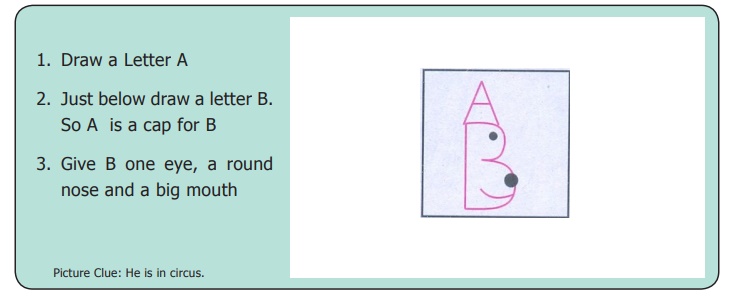
Write step by step instructions for the following picture.
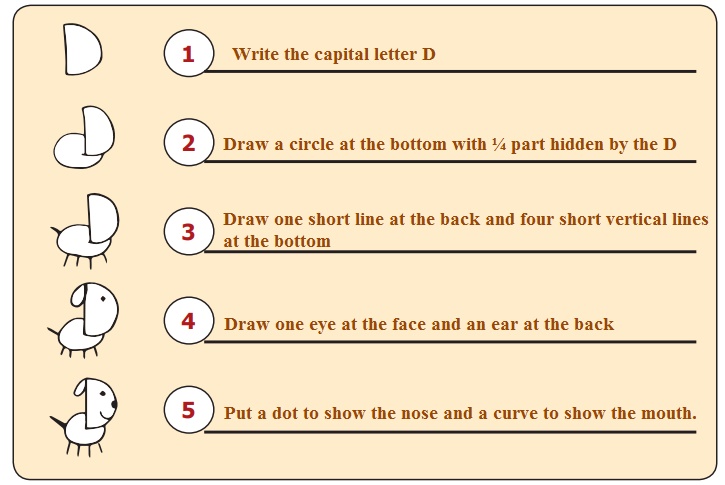
Section I
GLOSSARY
congested – overcrowded
grunted – made a low sound
crouching – sitting on heels
determination – firmness to do something
Which of the two sentences given below convey the following meaning?
1. stained by – mark made on clothes or materials
The white washed walls were stained by many monsoons. ______________
a. The walls were made dirty by rains. ✓
b. The Monsoon removed the dirt from the walls.
2. working for a pittance – working for very little money
I am tired of working for a pittance.
a. He didn’t want to work because he was tired.
b. He didn’t want to work as he gets low income for his work. ✓
3. ashen – pale
His face was ashen.
a. He looked pale and dull. ✓
b. He looked bright and cheerful.
4. drenched – thoroughly wet
He is drenched to the skin. ______________
a. He is thin and skinny.
b. He is thoroughly wet. ✓
Additional questions :
1. How did the old man earn his living?
The old man earned his living by carving stones for the temple.
2. What did he use for his work?
He used a hammer and a chisel for his work.
3. What was the workroom like?
The workroom was small and congested. The walls were stained by many monsoons. The window was without curtains.
4. What did his son tell him? Why?
His son said that he was leaving for Agra because that kind of work did not pay them well.
5. Why did the old man continue to do the work?
The old man felt that money didn’t matter. He felt that it was a service to God.
6. Who was Salim? What did he bring the old man?
Salim was the servant boy. He brought the old man a glass of steaming tea.
7. What was the old man like?
The old man’s face was ashen. He looked tired.
8. Why do the stone carvers go to Agra?
In Agra, the stone carvers could turn out cheap candlestands, paper weights and ashtrays by the dozen. It gives them more money. So the stone carvers go to Agra.
9. What do you know about Salim?
Salim was an orphan boy. He came to work for the old man five years ago. When he came there he was wet to the skin and he begged for shelter. He had then stayed on to work for the old master craftsman.
10. How did the old man feel when he picked up the hammer and chisel?
When the old man picked up the cool tools he was filled with happiness and confidence.
Paragraph writing
1. Describe the events leading to the old man’s son leaving him.
The old man was a master craftsman. He carved stones to make statues for the temple. Gopal was his son. One day his son came to him. He said that he was tired of working for a pittance. He added that he could earn more if he went to Agra. So he took leave of his father and quit the place. On hearing this his father was broken-hearted. He was sad that there was no one after him to keep up the age-old tradition.
2. What do you know about Salim and his master?
Salim was an orphan boy. He came to the old man five years ago. When he came there he was in tatters. He was drenched to the skin. He asked for shelter. He stayed to work with the old man. Soon he had grown tall and strong. Salim was helpful to the old man. He took care of him prepared food for him.
Section II
GLOSSARY
serene – calm
blurred – become unclear
blush – show shyness
Read the sentences and number them in correct order.
1. The old man worked tirelessly on the sculpture. 1
2. He had a strong wish to finish it in time. 2
3. Over days, he felt very weak. 3
4. He thought he wouldn’t be able to finish it. 4
5. He wished to have Gopal with him. 5
6. He realized that Gopal must learn to carve the finer details. 6
7. Salim felt that it should come from within. 7
Additional questions :
1. What could the old man see in the stone?
The old man could see the strong, straight shoulders of Krishna. He saw his soft lips and his fingers holding the flute to his lips. He also saw the serene face which was eternally beautiful.
2. How did the old man work?
The old man worked tirelessly. He did not feel hunger or thirst. He was bent on finishing the sculpture in time.
3. How did the old man feel about his work?
It was the biggest and the best work for the old man. He felt that it would be his last work.
4. How did the old man feel when he became weak?
The old man felt his strength ebb. His shoulders began to ache. His arms became heavy. His vision blurred.
5. What did the old man think of Gopal?
Gopal hadn’t learnt the finer details. But the old man felt that he would have learnt it in a year or two.
6. What did Salim say about the finer details?
Salim said that it should come from somewhere deep inside the heart.
7. What should a sculptor do if he didn’t have it inside?
If a sculptor didn’t have it inside he had to go to Agra and mass produce ashtrays for tourists.
8. What happened to the old man after he had worked for a long time?
The chisel fell from his hand. The hammer dropped to the ground. His old body sagged and he fell down.
9. What happened to the old man when he fell down?
When the old man fell down his forehead struck Krishna’s flute. His body fell to rest on the pedestal.
10. What was the condition of the old man when he opened his eyes?
The old man found himself lying on a cot in his bedroom. He was covered by a light cotton blanket.
Paragraph writing:
1. How did the old man work hard to carve the statue?
The old man worked tirelessly. He wanted to set free the beauty of Krishna with his chisel. He did not feel hunger or thirst. He thought that it was his biggest work, his best. He also knew that it would be his last. On and on he worked. His chisel was striking again and again.
2. What happened to the old man when he became weak?
The old man felt his strength ebb. His shoulders began to ache. His arms felt heavy. His vision blurred. He coughed painfully. One day he worked till late in the night. Early in the morning the chisel fell from his hand. The hammer dropped to the ground. His old body sagged. The old man fell forward limply. His forehead hit Krishna’s flute and his body slid down to the pedestal.
Section III
GLOSSARY
stumbled – lost balance
immobilized – stopped from moving
tottered over – moved unsteadily way
startled – surprised
Read Section – III (para 1 and 4) and answer the following questions.
Paragraph 1
1. Who listened to the chipping sound of the chisel? The old man
2. Who was working with the hammer and chisel? Salim
Paragraph 4
1. Who was staring? The old man was staring.
2. Who was the young stone carver? Salim was the young stone carver.
3. What was he working on? He was working on the face of the statue, on the eyebrows.
Additional questions :
1. What did the old man hear from the workshop?
The old man heard the chipping sound of the chisel from the workshop.
2. What did the old man think when he heard the chipping sound of the chisel?
The old man thought that his son Gopal had returned home.
3. What did the old man do when he heard the chipping sound of the chisel?
On hearing the chipping sound of the chisel the old man stumbled to his feet. He crossed the small room and reached the door.
4. Why couldn’t the old man move?
The old man couldn’t move because shock had immobilised him.
5. Who was working on the face of the statue?
Salim, the servant was working on the face of the statue.
6. How did the old man feel at first?
At first the old man was filled with shock, fear and anger.
7. What happened when his fear and anger disappeared?
The old man had a feeling of great relief and happiness.
8. What did Salim say to the old man?
Salim said that he only wanted to help him. He added that he had been practising for two years in a quarry.
9. What was the ambition of Salim?
For many years Salim wanted to become a sculptor like the old man.
10. What did the old man say to Salim in the end?
The old man said that Salim had the skill in his hands and heart. He added that Salim would become one of the country’s finest stone carvers.
Paragraph writing
1. Describe the feelings of the old man when he heard the chipping sound of the chisel.
When he heard the chipping sound of the chisel the old man could not believe his ears. At first he thought that his son Gopal had come back. He was about to shout. But the words froze on his lips. He became immobilised with shock. He saw that it was his servant Salim. The old man was filled with shock, fear and anger. Then his fear and anger disappeared. He was filled with great relief and happiness.
2. What did the old man do when he saw Salim working on the face of the statue?
At first the old man was filled with shock, fear and anger. Soon he was filled with great relief and happiness. He laid his hand on Salim’s shoulders. Now Salim expressed his desire to become a sculptor like the old man. The old man said that Salim had the skill in his hands and heart. He said that Salim would become one of the country’s best stone carvers.
Vocabulary
A. Arrange the words in alphabetical order, find the meaning of the words from the dictionary and fill in the blanks.
Ikebana | Appliqué | Origami | Calligraphy | Tapestry
1. Applique – a type of needle work in which small pieces of fabric are sewn or stuck in pattern on to a larger piece.
2. Calligraphy – beautiful handwriting.
3. Ikebana – the Japanese decorative art of flower arrangement.
4. Origami – Japanese art of folding paper.
5. Tapestry – a cloth with designs or figures woven into it.
B. Match the tools with art forms.
Column A – Column B
1. Hammer and chisel – Painting
2. Paint brush and palette – Sculpture
3. Moulds and roll pin – Embroidery
4. Scissors and paper – Pottery
5. Needle and thread – Collage
Answer:
Column A | Column B
1. Hammer and chisel – Sculpture
2. Paint brush and palette – Painting
3. Moulds and roll pin – Pottery
4. Scissors and paper – Collage
5. Needle and thread – Embroidery
Language Check Point
Do you see a red car outside? – see – something that you do naturally without thinking
Look at the blue bird in the tree. – look – make an effort to see something
I don’t have time to watch TV now. – watch – something you look at for a period of time
Listening
C. Listen to the teacher reading the passage. Read the questions given below, then listen to passage again and complete the responses.
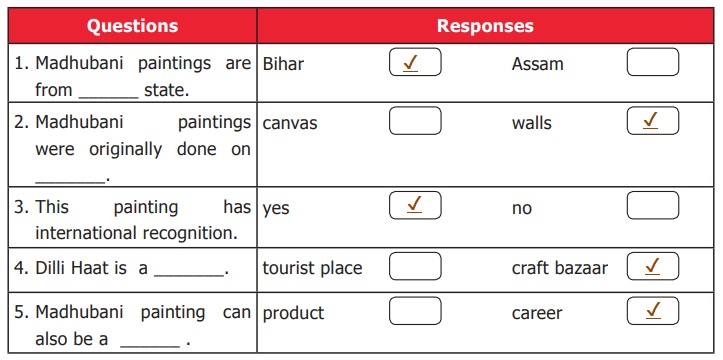
Madhubani painting or Mithila paintings from the Mithila region of Bihar were originally done on walls during festivals and other such occasions. The artists like Jagdamba Devi and late Mahasundari Devi are responsible in getting it international recognition. Madhubani paintings find a pride of place in our homes today. One can see the tourists flocking to the Madhubani stalls in craft bazaars like the Dilli Haat. It needed educated and ethnically aware people to bring this aspect of our culture on the international scene and make the younger generations take pride in them so that they voluntarily made a studied choice of them as career options.
Speaking
D. Work in pairs. Find answers to these questions and present it to the class.
* Do you have art / craft session in your school?
We have art session in our school.
* Which session do you like – art / craft?
I like art session.
* What do you do in that session?
We draw beautiful pictures.
* Do you work individually or in pairs?
We work individually.
* Can you do an art work or a craft work on your own?
I can do art work on my own.
* What qualities do you gain by doing art or craft?
I develop the skill of drawing and painting. I give freedom to imagination.
Grammar
PICTO GRAMMAR
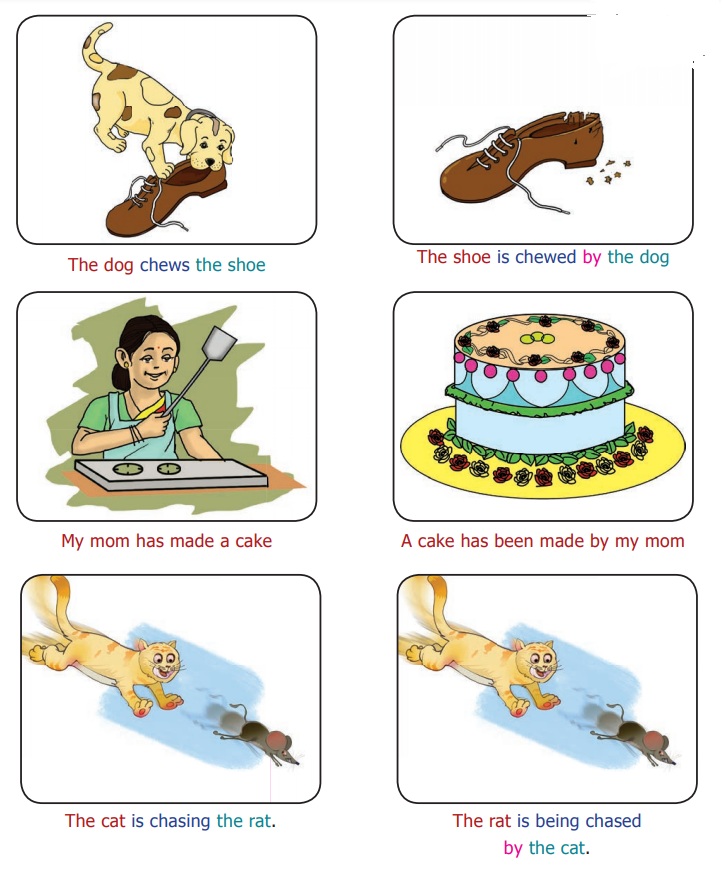
Note to the teacher
In the active voice, the subject performs the action.
In the passive voice , the subject receives the action.
USE GRAMMAR
E. Construct meaningful sentences from the table given below.
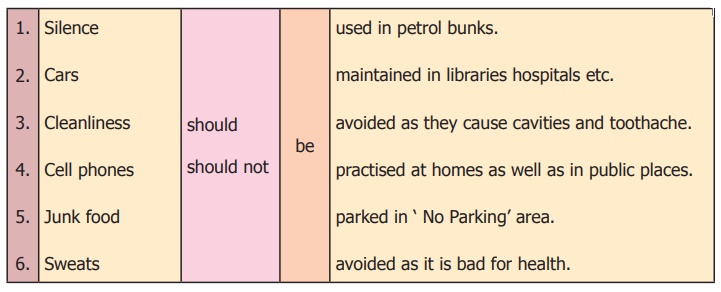
1. Silence should be maintained in libraries, hospitals etc.
2. Cars should not be parked in ‘No Parking’ area.
3. Cleanliness should be practised at homes as well as in public places.
4. Cell phones should not be used in petrol pumps.
5. Junk food should be avoided as it is bad for health.
6. Sweets should be avoided as they cause cavities and toothache.
A note on-usage : petrol bunk × (wrong)
petrol pump ✓ (correct)
F. Read the news report given below and underline the passive form of verbs.
The police had announced that the State Bank of India was robbed yesterday. Two men entered the bank at 4.30 pm with guns in their hands. Customers and bank clerks were asked to lie down on the floor, and one of the bank clerks was made to fill robbers’ bags with money. After that the two men left the bank quickly. The police officer said that more than one lakh of rupees was stolen from the bank but nobody was injured. He also added that the robbers would be found soon.
The police had announced that the State Bank of India was robbed yesterday. Two men entered the bank at 4.30 pm with guns in their hands. Customers and bank clerks were asked to lie down on the floor, and one of the bank clerks was made to fill robbers’ bags with money.
After that the two men left the bank quickly. The police officer said that more than one lakh of rupees was stolen from the bank but nobody was injured. He also added that the robbers would be found soon.
Work in pairs
G. Rani’s teacher narrates to her students about the production of paper. Read the following narration and fill in the blanks with the verbs using their passive form.
People of China produced paper from wood. They mixed water with the fibres of wood and dried it, until they became a soft wet pulp. They used this pulp to make paper. The Chinese invented this method of paper making in 2nd century BCE. Later Egyptians used papyrus plants to make paper.
1. Paper was produced (produce) from wood.
2. The fibres of wood from trees were mixed (mix) with water to make a soft wet pulp.
3. Later, it was dried (dry) to make paper.
4. This method was invented (invent) in 2nd BCE in China.
5. Papyrus plants were used (use) by Egyptians to make paper.
H. Read the process of making soup. Use suitable passive form of verbs and complete the paragraph.

The packet is opened and the contents (i) are mixed with 750 ml of water, without allowing it to form lumps. The mixture (ii) is poured into a heavy-bottomed vessel It (iii) is brought to a boil, stirred and simmered in low flame for five minutes. The soup (iv) is transferred into soup bowls and (v) garnished with fried corns.
Writing and Creative Writing
WRITING
I. If you are asked to choose from any one of these toys which one do you choose? Give reasons.(plastic toys, wooden toys, clay toys, metallic toys)
I would choose clay toys. Plastic toys and metallic toys are non biodegradable. When broken they remain in the soil for hundreds of years and cause land pollution. Wooden toys look beautiful. But cutting trees to make toys leads to deforestation. So I can avoid it. Clay toys come in different colours. They can be moulded to any shape easily. They don’t cause land pollution. So I would like to choose clay toys.
J. Your friend has presented a beautiful art piece on your birthday. Write a letter to her appreciating her art work.
24th October, 20
Chennai.
My dear Janani,
I received the beautiful model of Taj Mahal sent by you. It is a wonderful birthday gift. It looks artistic and amazing. I am delighted to keep it on my table. Whenever I see it I remember you. It reminds me of your love and affection. I thank you for your beautiful gift.
With warmest thanks.
Yours lovingly,
R. Priyanka
CREATIVE WRITING
K. You have prepared some eco-friendly craft materials like paper matche dolls, greeting cards, book marks, festoons, garlands, quilling jewellery etc for an Art Mela to be conducted in you school premises. Describe in a few sentences how you made the craft work. Include the following details in your writing.
• Name of the craft work
• Materials used
• Nature (handy / eco-friendly, longlasting / affordable price )
• Use (place / person / time)
I made a beautiful garland of flowers for the Art Mela. I used papers in different colours. Using scissors, glue and thread I made flowers of different colours. I also made rings to join them. The materials used by me were handy and eco-friendly as they had no plastics. They are long lasting. These garlands can be made by anyone at affordable price. We can use these garlands at home, schools and offices. Any one can use such garlands to celebrate functions like birthday parties or festivals. The garlands look attractive and amazing.














